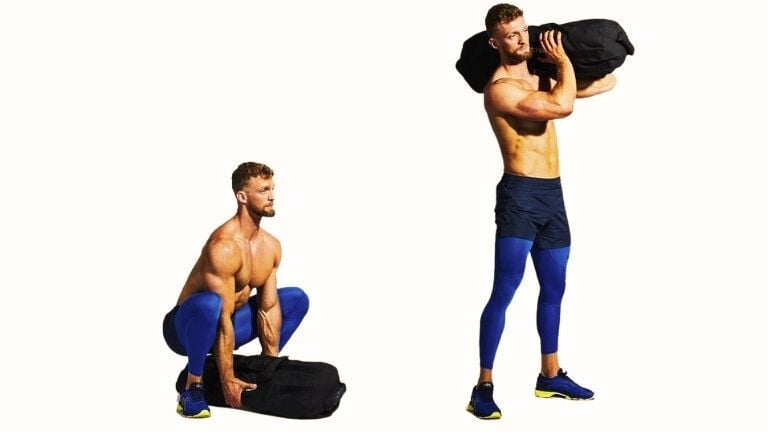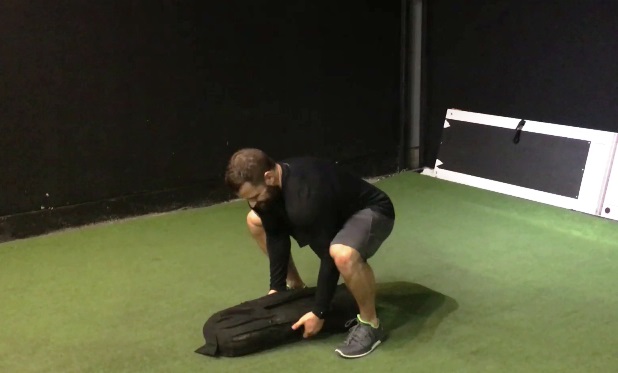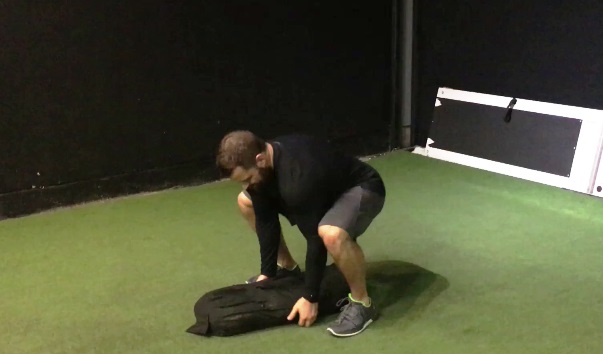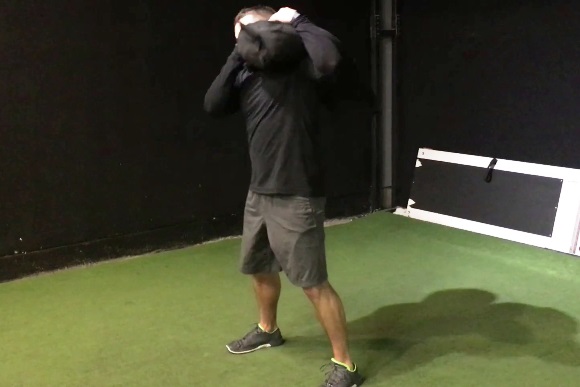if you’re looking for a workout that builds strength and helps you balance, stabilize, and activate your core, look no further than sandbag shouldering.
In today’s fitness landscape, sandbag shouldering is a good way to build strength. This age-old technique, which has been reborn in modern gyms, bridges the gap between traditional weightlifting and real-world motion.
Dive into the world of sandbag shouldering and discover how this versatile training modality can elevate your fitness game.

What is Sandbag Shouldering
Sandbag shouldering is a full-body exercise that works both strength and conditioning simultaneously. It involves lifting a sandbag from the ground and shouldering it, then lowering it back down to the ground.
It requires core stability, posture control, grip strength, and mental toughness to continue pushing through the burn. The exercise targets multiple muscle groups, including the legs, back, shoulders, and core.
Unlike regular dumbbell shoulder presses or lateral raises, sandbag shouldering challenges your entire body with the dynamic loading of the shifting sand within the bag.
For decades, athletes such as MMA fighters, soldiers, and CrossFit enthusiasts have used sandbag training to improve their conditioning and work capacity.
Want to take your gains to the next level? Discover your daily calorie needs with our free TDEE calculator
Muscle Worked During Sandbag Shouldering
Sandbag shouldering is a compound, full-body exercise. Because of this, it works multiple muscle groups throughout the body.
The primary muscles worked during sandbag shouldering are the glutes which are responsible for lifting the sandbag from the ground, and the shoulders, which are responsible for shouldering the sandbag.
In addition to the glutes and shoulders, sandbag shouldering also targets the following muscles to a lesser degree:
- Biceps
- Forearms
- Hamstrings
- Quadriceps
- Core
- Back muscles
How Muscles Worked
Legs
- Quadriceps (Front Thighs): These muscles are engaged when squatting down to pick up the sandbag and then extending your knees to lift it.
- Hamstrings (Back Thighs): They play a role in the hip hinge when you bend to pick up the sandbag.
- Glutes (Buttocks): These are engaged when you’re driving upwards, extending your hips to lift the sandbag.
Core
- Rectus Abdominis: The main abdominal muscle stabilizes your torso during the lift.
- Obliques: works when you’re lifting the sandbag to one shoulder.
- Erector Spinae (Lower Back): These muscles help stabilize your spine and are involved in the hip hinge.
Upper Body
- Deltoids (Shoulders): They work as you raise the sandbag towards your shoulder.
- Upper Trapezius and Rhomboids (Upper Back): These muscles help stabilize and retract the scapula during the lift.
- Latissimus Dorsi (Lats): These large back muscles aid in pulling the sandbag upwards.
- Biceps Brachii: Engaged when pulling the sandbag towards your body.
- Forearms: These muscles help grip and control the sandbag throughout the movement.
How To Do Sandbag Shouldering
Sandbag shouldering is a powerful full-body exercise that targets numerous muscle groups and improves overall functional strength. Here’s a step-by-step guide on how to perform the movement correctly:
1. Setup
- Select the Sandbag: Begin with a weight that’s manageable, especially if you’re new to this exercise. Sandbags can vary in size and design, so ensure you can grip it securely.
- Position: Stand over the sandbag with your feet shoulder-width apart, toes pointing slightly outward.
2. Starting Position
- Bend at the Hips and Knees: Lower your body down into a squat-like position. Keep your chest up, back straight, and eyes forward.
- Grip the Sandbag: Place your hands securely on the sandbag. Depending on its design, you might grab handles, or you might grip the bag itself.

3. The Lift
- Engage Core: Hold your core tight like you’re getting ready for a punch to the stomach.
- Lift with Legs: Drive through your heels, extending your hips and knees. Use the power of your legs rather than your back to initiate the lift.
- Use Momentum: As the sandbag rises, use some momentum to help swing it upward.

4. Shouldering the Sandbag
- Transition to Upper Body: Once the sandbag reaches about waist height, transition to pulling the sandbag upwards with your arms and back.
- Catch on Shoulder: As you continue to lift the sandbag higher, bend your knees slightly and “catch” or guide the sandbag onto one of your shoulders. The bag should rest securely across your upper back and shoulder.

5. Return and Alternate
- Lower Safely: Bend your knees and use your legs, hips, and core to control the descent of the sandbag back to the ground.
- Alternate Shoulders: If you’re performing multiple repetitions, alternate the shoulder you’re lifting the sandbag onto with each rep to ensure balanced muscle engagement.

Tips and Proper Form
- You should start with a manageable weight, around 10-20lbs, to work on form.
- Keep your back straight; no rounding or arching. Chest up, eyes forward.
- Feet shoulder-width apart, flat on the ground, pushing through heels.
- Tighten core muscles throughout for stability and back support.
- Initiate the lift using your legs, similar to a squat. Avoid back-dominant lifting.
- Firmly grasp the sandbag, whether on the handles or the bag itself.
- Use controlled, fluid movements. No jerking.
- When placing the sandbag, bend the knees slightly. Ensure even placement on the shoulder.
- With each rep, switch shoulders to get a balanced development.
- You should inhale when preparing to lift, and exhale when lifting onto the shoulder
- Schedule sandbag training 2-3 times per week for best results.
To Stay Motivated: 150+ Gym Workout Motivational Quotes To Stay Fit
The Benefits of Sandbag Shouldering
Sandbag shouldering is a versatile exercise that provides numerous benefits for strength and conditioning. The benefits of sandbag shouldering are as follows:
- Full-body workout: Sandbag shouldering is a full-body exercise that targets almost every muscle in the body, from the quadriceps and glutes to the core and shoulders.
- Strength and conditioning: It both strength and conditioning simultaneously. It is a great way to improve your fitness.
- Unique resistance: The unstable and off-balanced nature of a sandbag provides dynamic resistance, which is much more difficult than conventional lifting.
- Muscle imbalances: Sandbag shouldering can help to close the gap between any muscle imbalances or weaknesses.
- Improved Grip Strength: Enhances grip strength as the hands work to hold the sandbag securely.
- Burns Calories: High-intensity movement that can help in burning calories and fat.
- Versatility: Sandbag shouldering can be done with different variations, such as single-arm, rotational.
Conclusion
Sandbag shouldering isn’t just another fitness trend; it’s a combination of old-world strength and modern-day functional training.
The exercise has many benefits, such as strengthening your core and improving balance and coordination. It also strengthens your entire body.
So, what are you waiting for? Take on the challenge and enjoy the reward of sandbag shouldering. Give it a shot, and let the sandbag’s force lift your strength, stability, and endurance to new heights.

Manish brings over 10 years of hands-on experience in weight lifting and fat loss to fitness coaching. He specializes in gym-based training and has a lot of knowledge about exercise, lifting technique, biomechanics, and more.
Through “Fit Life Regime,” he generously shares the insights he’s gained over a decade in the field. His goal is to equip others with the knowledge to start their own fitness journey.
